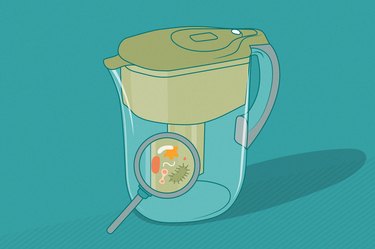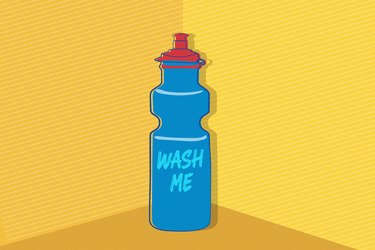
Let's face it — drinking plenty of water is one of the healthiest habits you can have. After all, the human body is made of 60 percent water, per the U.S. Geological Survey.
The thing is, how you drink your water matters.
Video of the Day
Video of the Day
If you're like many people, you have a water pitcher with a filter in your fridge (like a Brita) that you use to fill up your water bottle throughout the day. But whether or not you wash out that pitcher — or just fill it repeatedly until it's time to replace the filter — is anyone's guess.
So, how bad is it to never clean your water filter pitcher? (It's just water after all!) We talked to a food safety expert to find out.
Effects of Not Cleaning Your Water Pitcher and Filter
The truth is, if you don't wash your water pitcher, it can begin to grow mold or algae over time, says Martin Bucknavage, senior food safety extension associate at the Penn State Department of Food Science.
When water is filtered, contaminants like chlorine, lead and copper are removed, according to the water filter company Brita. But chlorine can be important.
"When chlorine is removed, there's nothing stopping organisms (like mold and algae) from growing in your water," Bucknavage says.
Plus, filters don't remove everything. Your pitcher itself can then become dirty, namely from microbes in the air that enter the container and set off organism growth, Bucknavage adds.
This growth might look like a light film on the bottom of your pitcher, something scientists call biofilm, per the National Cancer Institute.
"[A biofilm] is a combination of bacteria and other organisms that form a slime layer," Bucknavage says.
Once that biofilm, mold or algae takes up shop, especially in the filter housing where there are tons of nooks and crannies, it's tough to remove. And if the filter itself is contaminated, now your water probably is, too. (Not too refreshing, right?)
How does this affect your health? Well ultimately, it's possible for these waterborne germs to cause stomach illnesses, with symptoms like diarrhea, vomiting and nausea, according to the Centers for Disease Control and Prevention.
How Often Should You Clean Your Water Pitcher?
Ideally, you should empty out and wash your water pitcher and its filter once a week, Bucknavage says.
You should also wash it any time you go to change the filter, which will differ depending on the manufacturer's recommendations. (Read the directions for the one you own.) This doesn't mean you should only wash it when you change the filter, though.
Sticking to once a week will help keep biofilm from growing in the pitcher and the filter housing.
How to Wash a Water Pitcher and Filter
Washing a water pitcher and its filter requires more TLC than an average pot or pan. Here's what Bucknavage says you're going to do:
Step 1: Grab a Clean Sponge, Brush or Dishrag
Emphasis on the word clean. Make sure you're using a new sponge, a freshly laundered dishrag or a clean brush. Otherwise, you can easily transfer germs from these surfaces into the water pitcher, thus contaminating your filtered water, Bucknavage says.
Whatever cleaning tool you choose, it should get into the crevices of the container.
Step 2: Use Warm Soapy Water
Dish soap and warm water are all you need to wash your pitcher. Prioritize cleaning your pitcher over the other dishes. It should go into the fresh, clean water first, Bucknavage says.
Step 3: Allow It to Air Dry
After washing, place the pitcher on a rack upside down so the water runs off and it dries. If you're going to speed things up using a kitchen towel, make sure it's freshly laundered.
What if You Have Mold in Your Water Pitcher?
If you've already found mold or biofilm in your pitcher, the first thing you should do is change the filter, even if it's too early to do so, Bucknavage says. It's possible mold has grown into the filter, so it wouldn't be healthy to drink water that ran through a contaminated filter.
Even in cases of mold, washing with soap and water will do the trick, Bucknavage says. White distilled vinegar is another option: "It will act as a sanitizer and break down mineral deposits," he says.
But remember, "keeping your pitcher clean and preventing mold to begin with is key," Bucknavage says.
Other Tips to Help Keep Water Filter Pitchers Clean
Though it's a common habit to add more water once the container starts looking low, try to finish the water and then refill it.
And when it comes to how long filtered water lasts in the fridge, there's no absolute rule. Ideally, use up the water within a few days to a week, Bucknavage says. (Keep it refrigerated, which will help prevent germ growth.)
Filtered water can "go bad" (remember, there is no chlorine in it to kill germs), and the idea is to prevent anything from growing in the first place.
So, How Bad Is It Really to Never Clean Your Water Pitcher?
If you notice a layer of slime in your pitcher, you should definitely clean your container out. Otherwise, not cleaning it regularly could set the stage for mold or algae growth, which ultimately means you're glugging contaminated H2O. Aim to wash your pitcher once a week.
Is this an emergency? If you are experiencing serious medical symptoms, please see the National Library of Medicine’s list of signs you need emergency medical attention or call 911.



